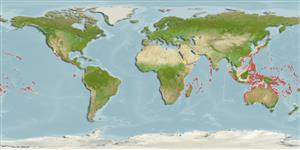Klassifizierung / Names
Namen | Synonyme | Catalog of Fishes (gen., sp.) | ITIS | CoL | WoRMS | Cloffa
Actinopterygii (Strahlenflosser) >
Perciformes (Perch-likes) >
Creediidae (Sandburrowers)
Etymology: Limnichthys: Greek,limne = swamp + Greek, ichthys = fish (Ref. 45335). More on author: Smith.
Lebensraum / Klimazone / Range
Ökologie
; seewasser demersal; tiefenbereich 4 - 20 m (Ref. 90102). Tropical, preferred ?
Indo-Pacific: from east Africa and Red Sea to western Australia, Taiwan and Ogasawara Is., Micronesia, the Hawaiian Is., the Cook Is., and the Pitcairn group.
Size / Gewicht / Alter
Maturity: Lm ? range ? - ? cm
Max length : 3.5 cm TL Männchen/unbestimmt; (Ref. 5467)
Rückenflossenstacheln (insgesamt): 0; Rückenflossenweichstrahlen (insgesamt): 22-25; Afterflossenstacheln 0; Afterflossenweichstrahlen: 26 - 28. Body pale, with 8-12 narrow, short bars across dorsal surface (Ref. 5467). Dorsal saddles not reaching, even if present, a lateral band. Combined number of soft rays in dorsal and anal fins usually 44 to 51 (Ref 12874).
Benthic in surge-swept sand patches and shorelines (Ref. 1602, 58302). Found in sea bottoms with coarse sand and fine gravel 4-20 m deep (Ref. 90102). Occurs in small groups that bury themselves in coarse sand patches on reef corners subject to currents (Ref. 48636).
Life cycle and mating behavior
Geschlechtsreife | Fortpflanzung | Ablaichen | Eier | Fecundity | Larven
Nelson, J.S., 1986. Creediidae. p. 736-737. In M.M. Smith and P.C. Heemstra (eds.) Smiths' sea fishes. Springer-Verlag, Berlin. (Ref. 5467)
IUCN Rote Liste Status (Ref. 115185)
CITES (Ref. 94142)
Not Evaluated
Bedrohung für Menschen
Harmless
Nutzung durch Menschen
Mehr Information
NamenSynonymeMetabolismusRäuberÖkotoxikologieFortpflanzungGeschlechtsreifeAblaichenFecundityEierEientwicklung
ReferenzenAquakulturAquakultur ProfilZuchtlinienGenetikAllel-HäufigkeitenVererbbarkeitKrankheitenVerarbeitungMass conversion
PartnerBilderStamps, CoinsLauteCiguateraGeschwindigkeitSchwimmstilKiemenoberflächeOtolithsGehirngrößeSehfähigkeit
Tools
Zusatzinformationen
Download XML
Internet Quellen
Estimates of some properties based on models
Phylogenetic diversity index (Ref.
82805): PD
50 = 0.5156 [Uniqueness, from 0.5 = low to 2.0 = high].
Bayesian length-weight: a=0.00389 (0.00180 - 0.00842), b=3.12 (2.94 - 3.30), in cm Total Length, based on all LWR estimates for this body shape (Ref.
93245).
Trophic Level (Ref.
69278): 3.1 ±0.2 se; Based on size and trophs of closest relatives
Widerstandsfähigkeit (Ref.
69278): hoch, Verdopplung der Population dauert weniger als 15 Monate. ().
Verwundbarkeit (Ref.
59153): Low vulnerability (10 of 100) .
